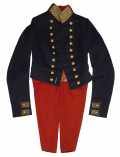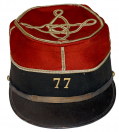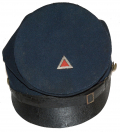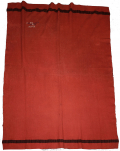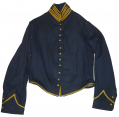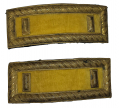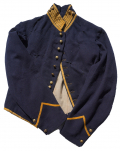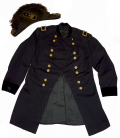site search
online catalog
Uniforms & Cloth
Showing 41 to 60 out of 191
REGULATION MODEL 1833/34 US ARTILLERY DRESS COATEE, MEXICAN WAR WORN
Offered is a US artillery regulation dress coatee worn by Lieutenant Julius Adolphus DeLagnel during the Mexican War. The emphasis is both on regulation and Mexican War! DeLagnel (also spelt… (88-209). Learn More »
$4,895.00
Originally $6,750.00
SOLD
A REGIMENTALLY MARKED FRENCH MODEL 1886 OFFICER'S KEPI
This one would date ca. 1910-14 in manufacture and was used in the opening battles of World War One 1914/15. The turban of the cap is red broadcloth cloth and it is 2 1/2-inches high. There is a black… (88-202). Learn More »
$345.00
Originally $395.00
ON HOLD
EXCELLENT PAIR OF US BOOTEES/BROGANS
This original pair of standard issue Jefferson Booties, often called “Brogans”, come to us in a virtually pristine condition relative to their age and materials of composition. Showing no signs of… (490-7151). Learn More »
CIVIL WAR BUMMER OR FORAGE CAP WITH NINTH CORPS BADGE
This is an excellent example of an original Civil War Union army regulation Model 1858 Forage Cap with a Ninth Corps badge on top, displaying the cross cannon and fouled anchor reflecting the origins… (1052-143). Learn More »
$4,000.00
Originally $4,500.00
COMMERCIAL, PRIVATE PURCHASE, CIVIL WAR BUMMER CAP WITH CORPS BADGE
Officers had to buy their own uniforms and headgear, but NCOs and even privates might occasionally also purchase a cap following the general lines of the government issue, but of better quality, more… (1052-202). Learn More »
$3,500.00
Originally $3,950.00
CIVIL FORAGE CAP BY MURPHY AND GRISWOLD WITH 14th CORPS BADGE
Thomas Murphy, William Griswold & Company were hatters on 19th Street in New York City and had major contracts for caps and hats with the U.S. government from 1862 to 1865, with the firm changing… (1052-227). Learn More »
$3,700.00
Originally $4,250.00
MCDOWELL PATTERN FORAGE CAP WITH FOURTH ARMY CORPS BADGE
This is a great example of the “McDowell” style cap popularized early in the war by General Irwin McDowell (1818-1835,) who was perhaps a bit more inspiring in haberdashery than generalship. The… (1052-146). Learn More »
$3,700.00
Originally $4,250.00
CIVIL WAR COMMERCIAL FORAGE CAP WITH MAINE BUTTONS AND ASSOCIATED INSIGNIA
Commercial caps were simply those purchased privately rather the issued by the government. They might more or less closely follow contract patterns with the purchaser able to suit his taste and… (1052-139). Learn More »
$4,000.00
Originally $4,500.00
IDENTIFIED ISSUE RED BLANKET OF THEODORE P. BOWKER 13th MASSACHUSETTS - DIED OF WOUNDS AT ANTIETAM!
This is a rare, early-war, identified Massachusetts issue red blanket carried by a soldier in the 13th Massachusetts who was wounded at Antietam on Sept. 17, 1862, and died of those wounds at a U.S.… (490-7138). Learn More »
$6,500.00
Originally $7,500.00
SUPERB, RARE MOUNTED SERVICE GREATCOAT
This style of cold weather coat is among those which replaced the long-standing model 1819/32 overcoat in favor of the US model 1851 style, the primary overcoat utilized by US army during civil war.… (490-7134). Learn More »
$8,500.00
ON HOLD
EXCELLENT CONDITION US CAVALRY SHELL JACKET
The body of this jacket is in excellent condition. There is no visible moth damage of any kind. All the piping is present and is bright. Both pillows are present on the back and are also in great… (490-7133). Learn More »
EXCELLENT CIVIL WAR FEDERAL SERGEANT CHEVRONS
This is an excellent pair of Civil War infantry chevrons. These are made of light blue worsted wool stripes sewn to a dark blue wool background patch, which in turn would be sewn to the sleeve of the… (490-7164). Learn More »
EXCELLENT PAIR OF CIVIL WAR FEDERAL INFANTRY REGULATION CORPORAL CHEVRONS/STRIPES
Union infantry companies fielded eight corporals. Along with the sergeants they might be charged with supervising squads or fatigue details, but in battle were posted in the front rank of the line of… (490-7163). Learn More »
RARE CONFEDERATE CAVALRY GUIDON
This Confederate guidon comes from the collections of the Texas Civil War Museum. The flag has been professionally conserved, matted, and framed by Textile Preservation Associates and comes with their… (1179-027A). Learn More »
EXCELLENT CONDITION, SCARCE SMITH PATENT CAVALRY FIRST LIEUTENANT STRAPS
Cavalry shoulder straps combine strong eye appeal from the yellow branch of service color with the romance associated with the mounted forces and are also scarce by comparison with infantry straps… (2024-1277). Learn More »
VERY LARGE US CIVIL WAR 34 STAR FLAG
The United States only used the 34-star flag from July 4, 1861 to July 3, 1863. This flag is entirely handmade of cotton bunting and meas. approx. 8.00 feet long on the hoist by 15.00 feet long on the… (766-1931). Learn More »
ZOUAVE FIRST SERGEANT CHEVRONS
These chevrons measure about 8 inches wide and 4 inches tall and use a red ground with three narrow, sewn, medium blue stripes and a diamond/lozenge, indicating a First Sergeant, the senior… (490-7153). Learn More »
$975.00
SOLD
UNION CAVALRY SHELL JACKET
The m1858 Mounted Services Jacket - trimmed in yellow - was ubiquitous among Federal Cavalry Troopers during the Civil War and into the West as a standard issue item. One of the war’s most… (2024-1844). Learn More »
$1,895.00
ON HOLD
MINT IDENTIFIED BREVET BRIGADIER GENERAL’S FROCK COAT AND CHAPEAU OF ALONZO ALDEN
This sets consists of Brevet Brigadier General Alonzo Alden’s mint condition brigadier general’s frock coat with shoulder straps and his full dress “light French chapeau,” allowed for officers… (1179-156). Learn More »
OFFICER’S GOLD TONE HAT CORD, ID’D TO COL. WILLIAMS, 9TH PA. CAVALRY
woven gold bullion cord, adjuster slide, and acorns. All in very fine condition. This has a verbal identification to Colonel Edward Williams, 9th Pennsylvania Cavalry. Author/historian Randy… (1256-108). Learn More »
Showing 41 to 60 out of 191
Most Popular
Historical Firearms Stolen From The National Civil War Museum In Harrisburg, Pa »
Theft From Gravesite Of Gen. John Reynolds »
Selection Of Unframed Prints By Don Troiani »
Fine Condition Brass Infantry Bugle Insignia »
British Imported, Confederate Used Bayonet »
Scarce New Model 1865 Sharps Still In Percussion Near Factory New »
featured item
CIVIL WAR OFFICER’S GILT BRASS EAGLEHEAD SPURS IN ORIGINAL COLOR
This is a very good condition set of nicely detailed eaglehead spurs with 80 or 90 percent of their gilt finish on the exterior, cast and chased with the outstretched wings making up the entirety of the sidebars. The wing feathers are in raised… (490-6821). Learn More »
site search
Upcoming Events
APRIL 12-13: SPRING GETTYSBURG MILITARY ANTIQUES SHOW; All Star Events Complex Learn More »



